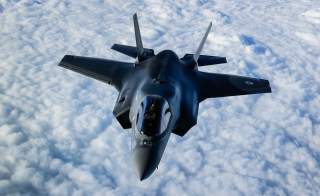Meet 'Skyborg': The Drone Wingman the Air Force Wants for the F-35
Why does it sound like of combination of "Skynet" and the "Borg"?
Key point: AI will help pilots in combat, but such advanced technology comes with risks.
The U.S. Air Force has selected its Skyborg wingman drone program to be one of its first “vanguard” technology programs. The designation means the flying branch intends to channel more resources toward the program and speed up its development.
The other two vanguard designees are the Golden Horde swarming munitions program and an experimental satellite. The Air Force plans to devote 20 percent of its roughly $3-billion annual science budget to vanguard programs.
“We believe they’re going to be game-changers,” Air Force Materiel Command head Gen. Arnold Bunch told reporters at a Defense Writers Group breakfast in late November 2019. “We believe they can dramatically change the way that we fight and the way that we employ air power.”
“We're not looking for … an incremental increase” in capability, Bunch said, according to National Defense Magazine. “The way that we see these, if we get these to work and … function in the way we expect, then it'll be a leap ahead.”
Skyborg is the overarching program for developing small, low-cost, high-performance armed drones that can accompany manned fighter jets into combat.
Commanded by a nearby fighter pilot or some other remote operator with a big assist from their own on-board artificial intelligence, the wingman drones could fly ahead of manned planes in order to extend sensor coverage. They could fire their own weapons at targets that the operators designate. A swarm of wingman drones also could absorb missile shots from enemy forces.
A new version of the Air Force’s F-35A stealth fighter, as well as the heavily upgraded version of the F-15 that the flying branch hopes to acquire, both could function as flight leads for the service’s wingman drones, Will Roper, the Air Force’s top weapons-buyer, told Defense News reporter Valerie Insinna.
The Air Force is in discussions with Boeing and Lockheed respectively to modify their F-15EX and F-35A Block 4 fighters to accommodate the datalinks and processors from the Skyborg effort, Insinna reported.
Roper told Insinna that pairing manned fighters with drones could “open up the door for an entirely different way to do aerial combat.”
“For example, take a typical four-aircraft formation and replace it with an F-15EX and three Valkyries,” Insinna explained.
“We can take risk with some systems to keep others safer,” Roper said. “We can separate the sensor and the shooter. Right now they’re collocated on a single platform with a person in it. In the future, we can separate them out, put sensors ahead of shooters, put our manned systems behind the unmanned. There’s a whole playbook.”
While the main Skyborg effort focuses on refining the software for wingman-drone ops, a separate effort develops the airframes. California-based Kratos has built several XQ-58 Valkyerie drones for testing. The first of the 29-feet-long drones took off for its first flight in March 2019.
The Air Force clearly has been pleased with the initial Skyborg testing and is optimistic about the technology’s potential. Air Force Research Laboratory commander Maj. Gen. William Cooley in September 2019 hinted that Skyborg would be a vanguard designee.
“There's really two pieces to that that are really important,” Cooley told Air Force Magazine. “One is the software side, to ensure that what we'd like to have is, I sometimes call it the brain that could fly virtually any vehicle, and write apps and add different capabilities within that software. The other is the other piece of this is the hardware side. There's lots of options on the hardware side.”
“The Valkyrie is one option, but there's other potential options that we want to keep in play,” Cooley added. “It really depends on what mission are we trying to perform? And, frankly, that's one of the other broad discussions relative to Skyborg, is there's a number of missions that different organizations within the Air Force would like to see us pursue.”
The Air Force wants wingman drones to be ready for combat by the mid-2020s. The vanguard designation could help focus resources on the effort and ensure the drones are ready on time.
“We've funded those for the next couple of years to make sure we've got all the efforts for the prototyping and experimentation that we want to move forward,” Bunch said.
David Axe serves as Defense Editor of the National Interest. He is the author of the graphic novels War Fix, War Is Boring and Machete Squad. This first appeared earlier in 2019.
Image: Reuters

